 en
en  en
en  en
en  en
en 
[226+ Pages Report] According to Facts & Factors, the global virtual reality (VR) in education market size was valued at USD 3.87 billion in 2023 and is predicted to surpass USD 18.01 billion by the end of 2032. The virtual reality (VR) in education industry is expected to grow by a CAGR of 18.65% between 2024 and 2032.

 Virtual Reality (VR) in Education Market: Overview
Virtual Reality (VR) in Education Market: OverviewVirtual reality in education refers to the use of computer-generated environments in the education system to improve the learning experiences.
VR technology offers a more immersive learning experience by helping users visualize complex concepts and further participate in simulations. Students can also attend virtual classrooms and learn in a risk-free & controlled environment.
VR has various applications in education, ranging from K2 education to corporate training. VR technology is proven to improve knowledge retention as students practically experience the situations rather than theoretically learning or reading about them.
 Key Insights
Key Insights
 Virtual Reality (VR) in Education Market: Growth Drivers
Virtual Reality (VR) in Education Market: Growth DriversThe recent boom of ed-tech platforms is expected to revolutionize the global virtual reality (VR) in education market. Such a high adoption rate of educational technology to offer interactive and immersive learning experiences is accelerating the demand for VR technology to replace and enhance traditional teaching methods.
Government initiatives include promoting VR technology to create a supportive and engaging environment. Governments are also offering grants and funding to encourage the adoption of VR technology in class and training centers.
VR technology improves student engagement rates. It is also known to offer better understanding and retention of information, particularly important for complex subjects.
VR technology is highly useful in disciplines like medicine, engineering, science, and history, where virtual simulations are important.
The increasing demand for a flexible learning environment is also strengthening the demand for virtual classrooms, field trips, and labs.
Governments all across the globe are investing in the digital transformation of the education system, which is further expected to positively impact the growth of the industry.
For instance, Varjo is the leading headset technology in the US Army's RVCT Air Program and came up with new headset models in 2023. These headsets are likely to help end-users in navigating exercises through computer-generated movements.
 Virtual Reality (VR) in Education Market: Restraints
Virtual Reality (VR) in Education Market: RestraintsThe high cost of headsets and other supporting hardware is a major factor likely to hinder the growth of virtual reality (VR) in education industry.
However, the prices of many of these equipment are falling, and the increasing requirements of advanced devices in many complex scenarios are likely to negatively affect the growth of the industry.
 Virtual Reality (VR) in Education Market: Opportunities
Virtual Reality (VR) in Education Market: OpportunitiesVR technology can offer personalized learning experiences by helping students learn according to their interests and requirements.
Additionally, VR solutions are being designed very sophisticatedly because of the rising demand for personalized educational environments.
Corporate training and skill development are other major factors likely to open numerous growth opportunities in the global virtual reality (VR) in education market. VR technology is gaining immense popularity in corporate settings as it helps in offering practical experiences to trainees.
Moreover, it is a more cost-effective training method because it is conducted in a risk-free environment. Trainees can work on complex tasks or hazardous environments without any risk of being harmed.
For instance, XRHealth, in partnership with HTC, came up with a new VR headset for mental health in 2023. This headset was offered to ISS to treat astronauts and address the rising concerns of isolation and stress.
 Virtual Reality (VR) in Education Market: Challenges
Virtual Reality (VR) in Education Market: ChallengesMany VR systems are not well-compatible with one another, thereby creating integration issues.
Moreover, this technology requires a stable and high-speed internet connection for real-time interactions, which is also affected by connectivity issues. Therefore, such a landscape is expected to be a big challenge in virtual reality (VR) in education industry.
 Virtual Reality (VR) in Education Market: Segmentation
Virtual Reality (VR) in Education Market: SegmentationThe global virtual reality (VR) in education market can be segmented into components, end-users, deployments, and regions.
On the basis of components, the market can be segmented into solutions, hardware, and software. The hardware segment will account for the largest share of virtual reality in education industry during the forecast period.
Growing demand for VR headsets is one of the major factors driving the growth of the segment. An increasing number of educational institutions are adopting VR technology and therefore posing high demand for HTC Vive, oculus, and many others.
Moreover, the ongoing advancements in VR hardware technology, like ergonomic designs, high comfortability, high-resolution display, wireless capabilities, and many others, are further strengthening the demand in the market.
Moreover, the falling prices of VR hardware set-ups are further likely to fuel the growth of the segment. There are many specific VR hardware for sectors like engineering, healthcare, and architecture to help users with better simulation and practical training.
Additionally, there is a growing demand for components like motion controllers, haptic feedback devices, and sensors in order to improve the interactive learning experience, which is another crucial factor likely to positively impact the growth of the segment.
On the basis of end-users, the market can be segmented into corporate training and academic institutions. The corporate training segment is likely to dominate the global virtual reality in education market.
The rising need for immersive learning experiences is accentuating the demand for virtual reality technology. This technology will help end users with a more immersive and engaging training experience. It also helps employees deal with real-time situations in a risk-free virtual environment to facilitate more practical training.
Also, it has emerged as a more cost-effective training method because it does not need any physical resources or travel for a dispersed workforce.
Also, it is an ideal solution for high-risk environments. Sectors like construction, oil & gas, defense, and many others use VR to structure a high-risk scene and help trainees practice their skills without risking their lives in real-time situations.
Also, there is a wider scope of customizable content to help trainers with specific modules according to their requirements.
On the basis of deployment models, the market can be segmented into on-premises and cloud. The cloud model will be the fastest-growing segment in virtual reality in education industry during the forecast period.
Cloud models are very cost-effective because they eliminate the requirement of any hardware and infrastructure, thereby helping companies eliminate high upfront costs.
Moreover, cloud-based models make virtual reality more accessible and affordable to universities, schools, and corporate institutes with limited budgets. There is an emerging trend in the hybrid learning model, which is another major factor positively impacting the growth of the segment.
Cloud-based VR solutions are easy to install and maintain compared to traditional on-premise systems. People can get new content, technical support, and software updates from the service provider, thereby eliminating the need for any professional help or additional infrastructure.
 Report Scope
Report ScopeReport Attribute |
Details |
Market Size in 2023 |
USD 3.87 Billion |
Projected Market Size in 2032 |
USD 18.01 Billion |
CAGR Growth Rate |
18.65% CAGR |
Base Year |
2023 |
Forecast Years |
2024-2032 |
Key Market Players |
Vuzix Corporation, Veative Group, Schell Games, Samsung Electronics Co. Ltd., Osterhout Design Group Inc. (ODG), Oculus VR LLC, Microsoft Corporation, Magic Leap Inc., Immersion VR, Google LLC, EON. Reality Inc., DAQRI LLC, Blippar.Com Limited, Avantis Systems Ltd., and Others. |
Key Segment |
By Components, By End-Users, By Deployment Models, and By Region |
Major Regions Covered |
North America, Europe, Asia Pacific, Latin America, and the Middle East &, Africa |
Purchase Options |
Request customized purchase options to meet your research needs. Explore purchase options |
 Virtual Reality (VR) in Education Market: Regional Analysis
Virtual Reality (VR) in Education Market: Regional AnalysisNorth America will account for the largest share of the global virtual reality (VR) in education market during the forecast period. North America is a leading region in the field of technological developments and innovations, which is a major factor in the high growth rate of the market.
The presence of major companies like Microsoft, Google, and Meta is another prime factor supporting the growth of the regional market. These companies have their headquarters in North America and are increasing their investments in VR technology, which is also expected to positively impact the growth of the industry.
The US and Canadian governments are also encouraging the integration of VR technology in education by offering federal and state-level funding.
North America is also witnessing increasing investment in the ed-tech field. Many start-ups and established companies are investing in VR technology, which is expected to revolutionize the market. Therefore, all these factors are expected to drive the growth of the regional market in the coming years.
Asia Pacific is another major region in virtual reality (VR) in education industry that is expected to witness heavy growth in the coming years.
APAC is witnessing a surge in the adoption of education technology, which is a prime factor likely to revolutionize the market in the region.
Educational institutes in the region are realizing the importance of digital transformation, and therefore, countries like South Korea, India, Japan, and China are encouraging organizations to adopt advanced tools like VR tech in education.
Countries are also coming up with many public digital educational programs to encourage the adoption of advanced technologies like VR into classroom learning. The rising trend of remote and online learning in APAC after the COVID-19 pandemic is also a major reason for the high growth rate of the regional market.
For instance, EON Reality Inc. collaborated with Holistic EHS to help businesses develop consulting offerings in 2023. The EON's AI-powered solutions are likely to offer new services to consulting clients in different regions.
 Virtual Reality (VR) in Education Market: Competitive Analysis
Virtual Reality (VR) in Education Market: Competitive AnalysisThe key players in the global virtual reality (VR) in education market include:
For instance, The government of India collaborated with IIT-Delhi to provide education on computer vision, blockchain, and AI technology. These courses were specially prepared for final-year students to improve employment opportunities.
The global virtual reality (VR) in education market is segmented as follows:
 By Components Segment Analysis
By Components Segment Analysis By End-Users Segment Analysis
By End-Users Segment Analysis By Deployment Models Segment Analysis
By Deployment Models Segment Analysis By Regional Segment Analysis
By Regional Segment Analysis

Copyright © 2024 - 2025, All Rights Reserved, Facts and Factors
 en
en  en
en